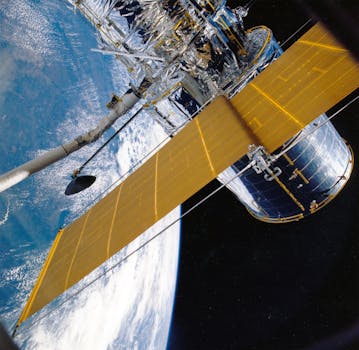
Beyond Earth: How Recent Advances in Satellite Tech are Shaping Global Communications
Recent advances in satellite technology are revolutionizing global communications, enabling faster and more reliable connectivity across the globe. The launch of new satellite constellations, advancements in antenna technology, and the development of more efficient propulsion systems are just a few examples of the innovations that are transforming the industry.
The use of satellites for communication purposes dates back to the 1960s, when the first commercial communications satellite, Intelsat 1, was launched. Since then, the technology has evolved significantly, with the development of more advanced satellites, such as geostationary satellites, which remain stationary in the sky and provide continuous coverage of a specific region. Today, satellites play a critical role in global communications, providing connectivity to remote and underserved areas, as well as enabling international communications and broadcasting.
One of the most significant recent advances in satellite technology is the launch of new satellite constellations, such as OneWeb and Starlink. These constellations consist of hundreds or even thousands of small satellites that work together to provide global coverage. They offer a range of benefits, including lower latency, higher speeds, and greater reliability, making them ideal for applications such as broadband internet, mobile connectivity, and IoT communications.
In addition to new satellite constellations, advancements in antenna technology are also playing a key role in shaping global communications. Phased array antennas, for example, are capable of electronically steering and shaping beams, allowing for more efficient use of spectrum and greater flexibility in terms of coverage. This technology is particularly useful for satellite communications, where the signal has to travel long distances and can be affected by various forms of interference.
Another important development in satellite technology is the use of more efficient propulsion systems. Traditional propulsion systems, such as chemical propulsion, are limited by their fuel efficiency and can take a long time to reach their destination. Newer propulsion systems, such as electric propulsion and advanced ion engines, offer greater fuel efficiency and can significantly reduce the time it takes for a satellite to reach its orbit. This not only saves time and money but also enables satellites to be launched into more complex orbits, such as highly elliptical orbits, which can provide greater coverage and flexibility.
Furthermore, recent advances in materials science and manufacturing are also contributing to the development of more advanced satellites. The use of lightweight materials, such as carbon fiber and aluminum, is enabling the creation of smaller and more efficient satellites, which can be launched at a lower cost and with greater ease. Additionally, advancements in 3D printing and other manufacturing technologies are allowing for the rapid production of complex satellite components, such as antennas and propulsion systems.
The impact of these advances in satellite technology is being felt across a range of industries, from telecommunications and broadcasting to navigation and Earth observation. In the telecommunications sector, for example, satellite communications are being used to provide broadband internet and mobile connectivity to remote and underserved areas, where traditional fiber-optic or wireless networks may not be available. This is particularly important in developing countries, where access to reliable and affordable communications is essential for economic development and social equality.
In the broadcasting sector, satellites are being used to distribute high-definition television channels and other forms of content to audiences around the world. This is particularly useful for international broadcasting, where satellites can provide a cost-effective and reliable means of distributing content to multiple regions simultaneously. Additionally, satellites are being used to provide emergency communications and disaster recovery services, such as backup connectivity and data storage, in the event of a natural disaster or other crisis.
In conclusion, recent advances in satellite technology are transforming the global communications landscape, enabling faster, more reliable, and more efficient connectivity across the globe. From new satellite constellations and advancements in antenna technology to more efficient propulsion systems and materials science, the innovations in this field are having a profound impact on a range of industries and applications. As the technology continues to evolve, we can expect to see even more exciting developments in the field of satellite communications, from the launch of new satellite constellations to the development of more advanced satellite components and systems.
The future of satellite technology holds much promise, with many experts predicting that it will play an increasingly important role in the development of a more connected and interdependent world. With the launch of new satellite constellations and the development of more advanced satellite components and systems, we can expect to see significant improvements in the speed, reliability, and efficiency of global communications. This, in turn, will have a major impact on a range of industries and applications, from telecommunications and broadcasting to navigation and Earth observation.
See more:





